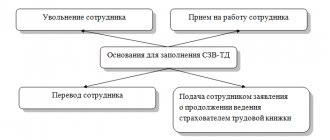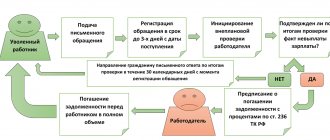The law obliges employers to make all payments due to them on the last working day of a dismissed employee: wages, bonuses, overtime allowances, compensation and others. In the article we will tell you how to calculate compensation upon dismissal if there is no average earnings, and we will give a formula for calculating it.
In order to calculate compensation for vacation that the employee did not have time to take before dismissal, you will need to know the average daily earnings (later in the article the abbreviation will be used - SDZ). An accountant must be able to calculate it correctly, since the calculation is influenced by many factors. In any case, the SDZ depends only on the employee’s income during work and the period of time worked. Therefore, if there is no average earnings to calculate compensation, it certainly needs to be calculated.
Calculation of an employee upon dismissal if there is no income
The employee does not have actually worked days and actually accrued wages for the billing period, before the start of the billing period and until V.K.’s dismissal.
Volkov was hired by Alpha LLC on December 16, 2014. The employee's salary is set at 15,000 rubles. and annual leave of 28 calendar days. From December 16, 2014 to January 31, 2015, the employee did not work due to downtime due to the fault of the organization. Volkov resigned. He did not take annual leave, so he is entitled to compensation for unused leave. The employee worked for the organization for less than 11 months, so he is entitled to proportional compensation.
Right to vacation
After six months of work without a break in this institution, the employee receives the right to half the established period of paid leave while retaining his position and average salary. Full leave can be obtained only after 11 months of work without a break. If there is a need to leave earlier than the specified period, you will have to write an application for unpaid leave.
The exceptions are employees under 18 years of age and pregnant women who want to take leave before or immediately after maternity leave. This category of workers has the right to receive paid days off before they have worked for six months. But here it should be taken into account that if you are dismissed ahead of schedule, there will be a need to return vacation pay.
Otherwise, it is advisable to adhere to the established vacation schedule, which is consistent with other employees and the employer. This rule will make the work of accountants easier.
Final payment upon dismissal of an employee
An important fact should be noted here. If the vacation was used by a citizen, but the period of work was not fully completed, accordingly, upon termination of the contract at the request of the latter, the employer has the right to withhold previously paid funds from his money.
The final settlement with the employee upon his dismissal implies the payment of funds that are due to the latter for the entire period of his working activity. In this case, it is necessary to take into account the grounds for termination of the contract. After all, a citizen’s salary and other necessary payments will depend on this basis. In such a situation, the manager should not forget that full settlement with the resigning person must be made on the day when the employee last carries out his activities in this organization. Otherwise, the boss simply cannot avoid problems with the law.
Interruption of vacation period
The working year may not coincide with the calendar year. For example, if you got a job not on January 1, but on May 30. In such cases, the working year begins on the day the cooperation agreement is concluded. The year end date may shift for reasons specified in Article 121 of the Labor Code.
Periods that are not included in the vacation period:
- maternity leave;
- leave without pay at the request of the employee for a period of more than 14 calendar days;
- absence from work without good reason, this also includes suspension from work, in accordance with Article 76 of the Labor Code;
Note: granting an employee unpaid leave for a period of less than 14 days is not grounds for interrupting the vacation period.
If there was no earnings for the last year, how to calculate compensation upon dismissal?
To calculate the average wage per day, the total real earnings received by the employee during the time period taken for calculation should be divided by 12, and then by 29.3 (the average monthly number of days).
139 of the Labor Code, which states that in all situations provided for, general rules are used. In this case, the calculation formula includes indicators of estimated time, number of days and total income. The exact calculation algorithm depends on how much the specialist actually worked in the billing period.
Calculation of average daily earnings if the billing period is not fully worked out: formula
In order to calculate SDZ when a period is not fully worked out, first find out the number of days in a given period:
KKD = 29.3: CKDM x CKDR , where
- CHKDM – number of days (calendar) in the month under consideration;
- NHKDR – the number of days (calendar) spent by an employee at work.
Formula for calculating SDZ:
SDZ = DRP: (29.3 x NCFM + NCDM) , where
- DRP – employee’s income for the billing period;
- NHOKM – the number of fully worked calendar months in the period;
- CHKDM – the number of calendar days in all months worked together in the period.
If several months were not fully worked out, the number of days in each of them is calculated separately, then the results are added up.
Calculation of compensation upon dismissal if there is no salary for the year
- We determine the number of months of work - 17 full months worked (since the reception date is June 2, the 14 days worked in November are discarded).
- We calculate the number of days for compensation - for the first year 28 days of rest were due and the employee received them, for the remaining 5 months you need to pay 28/12 * 5 = 12 days.
- We calculate the average daily earnings - 180 thousand rubles / 12/29.3 = 511.95 rubles.
- The compensation will be 12 days*511.95 rubles=6143.40 rubles.
- Social benefits - various benefits, including sick leave.
- One-time payments – financial assistance, etc.
- Some compensation payments are payment for rest, travel, food, accommodation, utilities, health care, use of personal transport, etc.
Proportional compensation
If for any reason an employee decides to quit without working the period required for full compensation, he is entitled to proportional financial compensation.
Example of calculating proportional compensation:
Suppose Sidorov S.S. decided to resign of his own accord after working for the company for 4 months and 20 days. According to the rules described in the Labor Code, the working period is rounded up to 5 months. The number of earned vacation days is calculated in proportion to the vacation period. The formula is simple: if there are 28 free days in 12 months, then in 5 months there are 5*28/12. As a result of simple calculations, we get 12 calendar days.
Calculation of an employee upon dismissal if there is no income
terminated upon expiration of the fixed-term employment contract. 19 jobs worked. days. Calendar salary accrued. = 1302 rub.
something is not enough - a month has been worked in full, and must receive no less than the minimum wage. Or will he work for you part-time?
Average daily earnings = 1302/25.48) = 51.10 rubles, where 25.48 calendar days per hour worked, recalculated taking into account the coefficient 29.4, i.e. = 29.4/30 * 26, where 26 calendar days per hour worked. Amount of compensation = 51.10 rubles * 2.58 calendar days of vacation (Article 267 of the Labor Code) = 131.84 rubles.
You are wrong, Uncle Fyodor, when you consider average earnings and compensation - everything will be in working days.
How to calculate average daily earnings when calculating compensation upon dismissal
Employee Rosomakhin V.M. worked for the company from April 18, 2015 with a salary of 20 thousand rubles/month. In the last year, based on the results of his work, he was awarded a bonus in the amount of 5 thousand rubles. Resigned due to staff reduction on 04/18/2017. Paid vacation days have been used in full. Over the past year, he has been on sick leave for a total of 20 days.
- Art. 139 of the Labor Code of the Russian Federation - it regulates the procedure for calculating dismissal payments;
- The regulation, approved by Decree of the Government of the Russian Federation of December 24, 2007 No. 922, discusses in detail the calculation methodology relating to the determination of average earnings for the accounting period in all legally valid situations.
We recommend reading: How to sell an inherited apartment
Extended vacation
There are certain categories of professions in which employees are entitled to increased leave. For example, for teachers, the duration of the main vacation can be 42 or 56 days, which is stipulated in Article 334 of the Labor Code of the Russian Federation.
If a teacher is entitled to 42 days of vacation, then upon resigning, he should receive compensation for unused vacation only if he worked for 11 months in the current working year.
If the teacher has earned paid leave for 56 days, then full monetary compensation must be paid if he honestly worked the entire academic year (10 months).
For example: Ivanov I.I. came to work at the school on August 27, 2014, and on June 30, 2015, wrote a letter of resignation of his own free will. Moreover, he hasn’t taken a vacation yet. During the current academic year, he honestly worked for 10 months and 3 days. According to the rules described in the Labor Code, the working period is rounded up to 10 months. In this case, Ivanov I.I. has every right to full compensation for unused 56 days of vacation.
Payment terms upon dismissal
When dismissing an employee (regardless of the reason for dismissal), the employer is obliged to make a final settlement with this employee, that is, he must pay all amounts due to the employee (unreceived salary, compensation for unused vacation.).
If an employee, for example, was on vacation or sick, that is, absent on the last day of work, and the organization’s salary is paid in cash, then the employer must make a payment upon dismissal no later than the day following the day when the employee applied for payment (Article 140 Tax Code of the Russian Federation).
Legislative acts on the topic
It is recommended to study in advance:
| Document | Name |
| Decree of the Government of the Russian Federation of December 24, 2007 N 922 | Calculation of SDZ for all cases, including dismissal |
| Art. 127 Labor Code of the Russian Federation | On payment of monetary compensation for unused vacation |
| Art. 181, art. 279 of the Labor Code of the Russian Federation, Resolution of the Constitutional Court of the Russian Federation dated March 15, 2005 No. 3-P | Grounds for calculating compensation to a dismissed director of an enterprise |
We calculate the average earnings for compensation upon dismissal - formulas, examples in 2019
Average earnings are an indicator that is calculated by an accountant according to special rules to calculate a certain payment intended to be issued to an employee. The value under consideration is used in the calculation of many payments; in this article we will consider its use in calculating compensation for unused vacation upon dismissal. Below are the current formulas for 2021 – 2018, rules and an example of calculating average earnings.
All other accruals are not subject to inclusion in the calculation of average daily earnings for compensation. That is, there is no need to take into account vacation pay, compensation for unused vacation days, sick leave, benefits, financial assistance, prize payments, travel allowance, compensation for travel, food, communications, etc.).
Calculation of average earnings upon dismissal
Hello! The employee has a monthly salary, for 06/01 to 06/26. Are the days actually worked taken for calculating SDZ or calendar days including days off? And what is the meaning of 26, I’m embarrassed to ask?
Hello! His monthly salary is 11,500, so it turns out that you need to take the actual days worked to calculate the SDZ? This turns out to be 11500r/29.4=391r this is SDZ, then 391r*15 (there are two more days of absenteeism there) =5867 So, did I understand or is something wrong? In addition, there is probably also compensation for unused vacation in the amount of 4 days
The procedure for calculating compensation upon dismissal if there is no average earnings
If the head of the enterprise has established part-time working hours for staff (for example, work lasts 4 days a week, not 5), the SDZ is calculated in the same way as if the employee worked the entire period taken for the calculation in full.
When it turns out that an employee’s work experience was less than a calendar year, the SDZ will be calculated based on the actual money earned for performing job duties and the number of visits to work. This amount must be divided by the number of days - you get SDZ.
How to determine average daily earnings if there were no accruals
It happens that an employee did not have any payments for a period. Then the SDZ is calculated as follows:
- If the employee did not work at all, or the entire period consisted of excluded days, then the value of the SDZ is calculated using information on wages for the previous year.
- If the employee did not carry out work either in the current or in previous periods, the SDZ is calculated based on the actual appearances at work during the month when it became necessary to find out the SDZ.
- If an employee has not worked a single day, the tariff rate approved for his position is taken.
How to calculate average earnings upon dismissal
Average daily earnings is the ratio of the total income earned by an employee during the pay period to the average number of calendar days in one month. It is 29.3 - this is a constant value (the indicator was established in 2014).
- conscription;
- significant changes in the terms of the employment agreement that caused the employee to refuse to further perform his duties;
- rejection of an offer to move to another city (region) due to the insistence of the employer;
- reinstatement of an employee who was previously employed in a specific position;
- medical indications, health status - an employee’s refusal to reassign personnel due to relevant indications or if the person can no longer remain in the workplace due to health reasons.
Calculation of an employee upon dismissal if there is no income
Accounting calculates these payments according to the algorithm provided by law, which is based on average earnings for a certain accounting period. Most often, the basis is taken as average daily earnings. Its calculation provides some nuances that should be followed in order to avoid financial errors. Let's look at how this indicator is calculated in various situations and give specific examples. Legislative norms Labor law and Government Decrees of the Russian Federation require managers and accountants, when calculating compensation and other payments upon dismissal, to be guided by the provisions given:
In this case, only the time after rehiring is taken into account for the calculation, since upon the first dismissal all due compensation was paid. Example: a driver worked for several years in an organization and then was fired due to staff reduction.
We recommend reading: Military pension for 25 years
The procedure for calculating average daily earnings to determine the amount of compensation upon dismissal
Taking into account the reason for dismissal when it is necessary to calculate the average pay for work is currently not strictly regulated by law. Real earnings are always taken into account, even when crimes are committed in the workplace. It can be entered into any calculator.
An employee’s income is all the official profit that is received from his place of work. But you only need to take into account that processing is carried out only for the amount earned after performing direct duties.
Typical errors in calculations
Mistake #1. The calculation of average daily earnings did not include downtime of the enterprise for technical reasons.
If the situation in which he was forced to find himself without work on a working day did not depend on the employee himself, he will retain his average earnings.
Mistake #2. When calculating the SDZ, the accountant did not take into account the period during which the employee was on a business trip because he was absent from the workplace.
During the business trip, the SDZ is retained by the employee.
What period to take to calculate average earnings upon dismissal?
The law obliges employers to make all payments due to them on the last working day of a dismissed employee: wages, bonuses, overtime allowances, compensation and others. In the article we will tell you how to calculate compensation upon dismissal if there is no average earnings, and we will give a formula for calculating it. In order to calculate compensation for vacation that the employee did not have time to take before dismissal, you will need to know the average daily earnings (later in the article the abbreviation will be used - SDZ).
- If you work in a company for less than 12 months, this entire period is in the billing period, i.e. from the first working day to the last day of the month before the month of dismissal.
- If an employee has worked for a company for 12 months or more, then all 12 calendar months during which he was employed before the month of termination of the employment contract are taken into account.
Calculation of average daily earnings for payment of compensation for unused vacation
To calculate the SDZ, you need to select a billing period (usually a year), find the total income, add bonuses, surcharges, etc. to its amount. The calculation scheme is as follows:
- The number of months worked is determined. If the employee did not work for a whole number of months, the indicator is taken without changes. If there were incomplete months, they are taken into account when working 15 days or more in each month and are discarded when working less than 15 days.
- The required number of vacation days is calculated.
- The days during which the employee managed to rest are subtracted from the number of days of rest.
- The result is multiplied by the SDZ.
Calculation of compensation upon dismissal if there is no earnings
How to calculate the average daily earnings upon dismissal Calculation methods are presented in the table: Included in the calculation of SDZ Not included in the calculation Any income in the company from which personal income tax and contributions to extra-budgetary funds were paid “Black” salary Bonuses, allowances Payments of a one-time nature Bonus based on the results years, long service payments, 13th salary Payments not related to wages (compensation, social benefits)
The reasons for calculating the SDZ may be the following circumstances: The calculation of the SDZ must be carried out to apply the obtained value in the calculation of all amounts due that the enterprise must pay to the resigning employee upon termination of the employment contract. Excluded periods If for some reason the employee did not work at his workplace, then under such circumstances there is no need to add payments for periods of incapacity for work to the basic income for the performance of official duties, when, by law, his average earnings were retained. Clause 5 of Regulation No. 922 specifies events that are not included in the billing period.
Answers to common questions
Question No. 1. How to calculate the amount of compensation for a dismissed company manager?
If this is the desire of the owner of the company, upon dismissal, the director of the enterprise will be paid compensation in the amount of 3 average monthly earnings according to the SDZ and the number of working days (hours) in the 1st month after leaving work.
Question No. 2. Is personal income tax paid on the amount of compensation for vacation that the employee did not have time to take before leaving work?
Yes, compensation for vacation does not apply to payments not subject to personal income tax.
Calculation of compensation upon dismissal if there is no earnings
Ivanova’s accruals for the billing period are summarized in the table: Month of the billing period Number of working days in the billing period according to the calendar Number of days actually worked in the billing period Average monthly number of calendar days Salary, rub. 2014 July 23 23 29.3 18,000 August 21 21 29.3 18,000 September 22 22 29.3 18,000 October 23 23 29.3 18,000 November 18 18 29.3 18,000 December 23 23 29 .3 18,000 2015 January 15 15 29.3 18,000 February 19 19 29.3 18,000 March 21 21 29.3 18,000 Total 185,185 – 162,000 Ivanova’s accountant calculated the average daily earnings of the organization as follows: 162,000 rubles. : 9 months : 29.3 days/month = 614.33 rub./day. The number of unused vacation days is: 28 days. : 12 months × 10 months = 23.3333 days. The total amount of compensation for unused vacation is: 614.33 rubles/day. × 23.3333 days = 14,334.35 rub.
During the billing period, care leave and personal leave, Lesnaya Byl LLC entered into an employment contract with E.S. Bogatyreva. But she was unable to start work on May 19, 2014. The employee had to take maternity leave for up to three years. Her child turned three years old on November 30, 2014. Without leaving maternity leave, she asked the employer to grant her leave without pay for two months - from December 1, 2014 to January 30, 2015. The employer agreed. January 19, 2015 E.S. Bogatyreva wrote a letter of resignation on February 1, 2015 of her own free will. Does an employee have the right to compensation for unused vacation upon dismissal and how to calculate it if she was not paid wages? Solution. Determining the number of days of unused vacation The employee’s working year began on May 19, 2014 and ended on February 1, 2015.
The legislative framework
Even if a person loves his job and is ready to work every day, he cannot do without vacation. Continuous work will lead to professional burnout, lethargy, moral and psychological exhaustion. Therefore, the Labor Code clearly states the rules for providing employees with free days to rest.
The duration of the vacation depends on certain factors , from the specifics of the activity to working conditions. But on average, a classic vacation is 28 calendar days. To earn these free days, you need to work properly for 11 months. Half of the established period can be used after six months of continuous work.
Advice: timely and adequate rest will be the key not only to your health, but also to productive work in the next working year. But there are situations when a person does not want or cannot go on vacation. In this case, unused free days are taken into account for subsequent use or compensated financially.
When an employee leaves, all unused but taken into account vacation days remain with him. Following Article 136 of the Labor Code, the amount of vacation pay must be accrued to the employee three days before dismissal. On the day of dismissal, the institution's debt to the former employee must be fully repaid.






